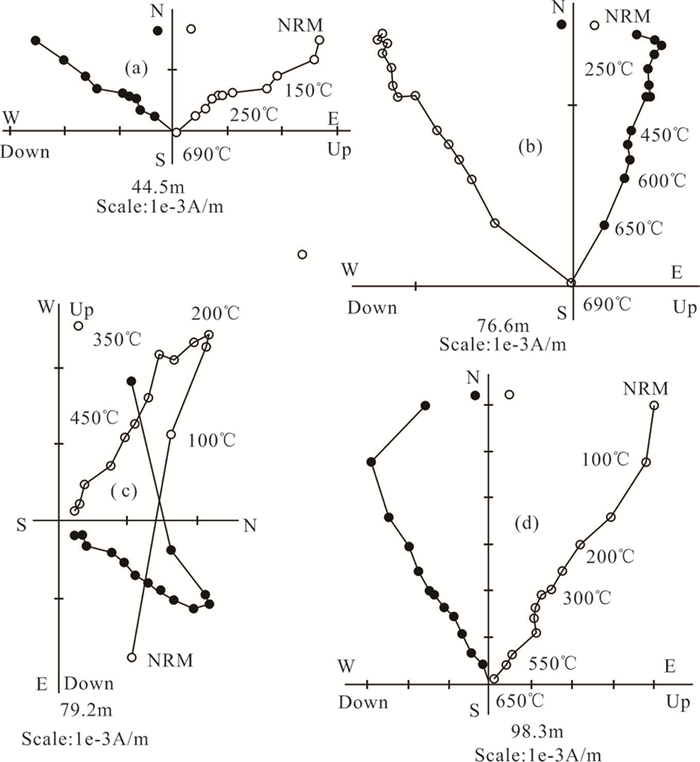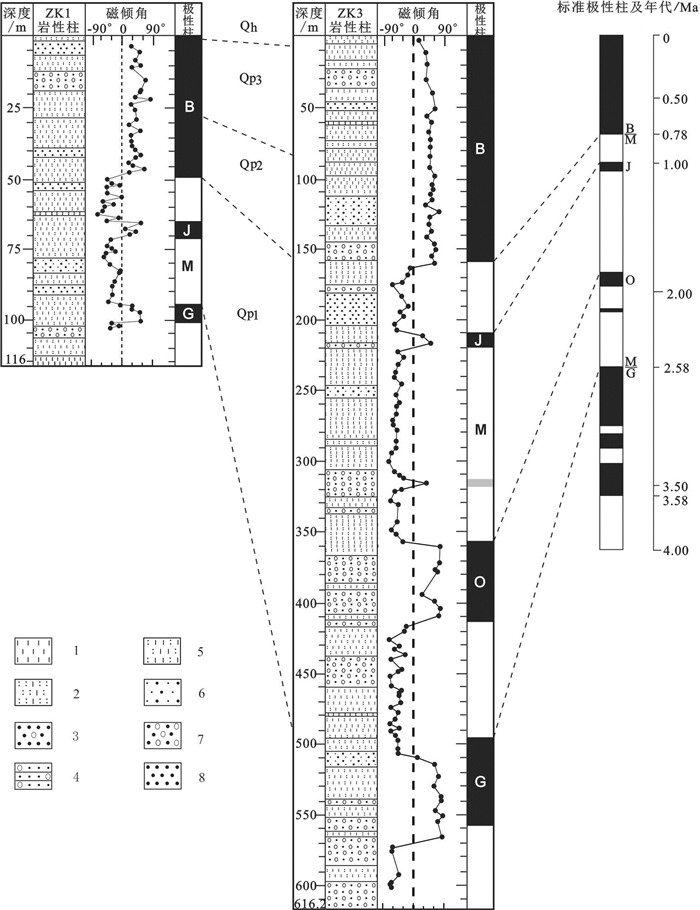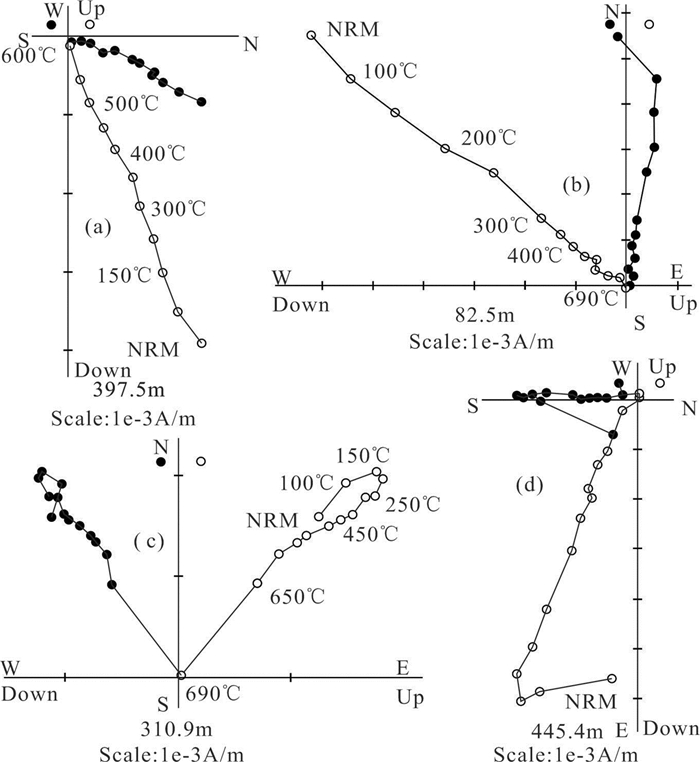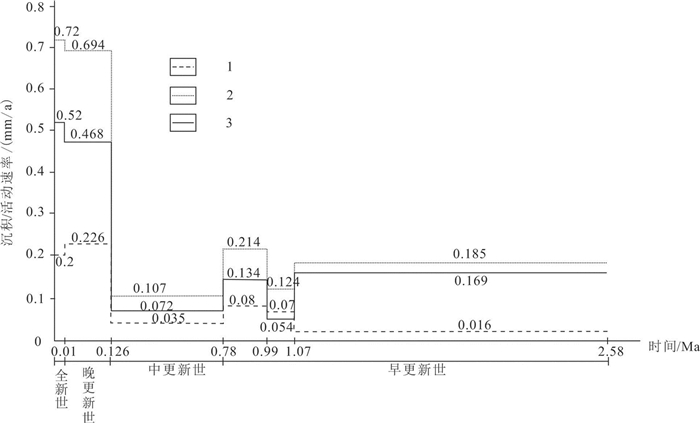Evaluation of the Nankou-Sunhe fault activity in Beijing based on the characteristics of magnetic strata and sedimentary strata
-
摘要:
南口—孙河断裂是北京平原区一条重要的活动断裂,也是渤海—张家口断裂带的组成部分。本文通过开展钻探和样品测试(古地磁和14C测年)分析工作,利用沉积相分析和磁性地层学技术方法建立钻孔沉积地层的磁极性年代序列,并对南口—孙河断裂北段进行第四纪以来活动性进行分析和研究。结果表明:南口—孙河断裂北段第四纪以来的活动性变化特征表现为早更新世早期(2.58~0.99 Ma)活动性由强转弱,在早更新世末期(0.99~0.78 Ma)再次转强;中更新世(0.78~0.126 Ma)活动性转弱;晚更新世至全新世(0.126 Ma至今)活动性再次加强。这一规律与北京西山隆升基本特征吻合,活动性总体表现“强-弱-加强”的特点。
Abstract:Nankou-Sunhe fault is one of most importance active faults in Beijing plain and one part of Bohai Bay-Zhangjiakou fault belts. This paper builds magnetic polarity chronology of borehole sedimentary strata based on magnetic stratigraphy and sedimentology with drilling and paleomagnetism and 14C samples testing, analyses and discusses the active features of NankouSunhe fault in the north segment since Quaternary period. The research indicates that:the fault activity changed from high to low intensity in the early stage of early Pleistocene(2.58-0.99 Ma)and turned into high intensity in the late stage of early Pleistocene (0.99-0.78 Ma), from strong to low intensity again in the Middle Pleistocene (0.78-0.126Ma), and then from low to high again intensity (0.126 Ma-present). This active feature is consistent with west mountain of Beijing uplift which shows the characteristics of high-low-high intensity.
-
1. 引言
活动断裂是一种现今正在活动的线性构造,它与地震和地质灾害关系密切。开展城市活动断裂的活动性研究,对于其土地利用及城市规划建设具有指导性作用(邓起东等,2003)。本次研究针对南口—孙河断裂开展钻探工程,通过利用详细的钻孔岩心、古地磁与14C样品分析与测试等技术方法,运用磁性地层学和沉积学方法对比分析断裂两盘地层沉积特征,划分地层等时面,进而揭示活动断裂的活动时间、活动强度等。该方法作为鉴定活动断裂的重要手段之一,在中国当前的城市活动断层探测工作中取得了广泛应用(向宏发等, 1993;车兆宏,1994;徐锡伟等,2000;江娃利等,2001;邓起东,2002;柴炽章等,2006;王丹丹等,2006;邱泽华等,2007;张世民等,2007;张世民等,2008;柯柏林,2009;刘保金等,2009;李乐等,2010;胡平等,2010; Wang et al., 2018;曹新文等,2018;戚帮申等,2019;赵衡等,2019)。
2. 南口—孙河断裂概述
南口—孙河断裂是北京市平原区一条重要的活动断裂,也是张家口—渤海地震带中隐伏、半隐伏的第四纪活动断裂。其北西端起自昌平区南口镇,向南东方向经七间房、百泉庄、东三旗、孙河至通州区,总体走向310°,长约80 km(图 1)。断裂表现为枢纽方式,北段自南口镇至北七家镇,断面倾向南西,倾角70°左右,控制了北西向马池口—沙河第四纪凹陷的发育,凹陷内第四系最大沉积厚度为600 m; 南段至北七家镇起至通州区,断面倾向北东,控制了顺义凹陷的南界的东坝沉积中心,凹陷内第四系最大沉积厚度为700~800 m。20世纪70年代末期北京地震地质会战期间布设了钻孔并进行了地球物理勘测,证实该断裂带在第四纪时期存在强烈活动(北京地质地震会战办公室,1982)。地貌学家也依据平原古河道变迁提出该断裂在全新世存在活动(徐海鹏等,1984)。20世纪90年代初,向宏发等(1993)通过浅钻,确认断裂断错了上更新世上部地层,同时通过开挖探槽,认为“南口—孙河断裂在最近的1.2万年以来仅发生一次约相当于7级地震的突发性断裂位错”,并得出该断裂全新世不活动的结论。江娃利等(2011)通过大探槽研究认为“该断裂在全新世时期有过三次古地震事件”,并得出了“北西向的南口—孙河活动断裂也是北京地区未来发生强震的构造”的结论。21世纪以来,多位的地质学者采用物探方法以及古地磁等测年方法,对南口—孙河的结构和活动性进行了评价,为后来研究其活动性奠定了基础(Kirschvink,1980;缪卫东等,2009;侯治华等,2011;赵勇等,2013;白凌燕等,2014;张磊等,2014;张晓亮等,2016;林良俊等,2017)。本文通过在南口—孙河北段东沙屯一带布设的ZK01与ZK03两个钻孔,进行地层的岩性分析、沉积相分析、以及古地磁信息提取等,建立本地区第四纪地层年代格架。通过对比不同地质时期断层两盘的沉积速率,进而获取南口—孙河断裂北段晚第四纪以来的活动特征。
3. 沉积地层与沉积环境特征
根据ZK01孔和ZK03孔岩心及和其沉积物特征,沉积物组合分成四类,分别代表了不同沉积环境。
3.1 ZK01孔岩心特征
ZK01孔,位于昌平区东沙屯村北,南口—孙河断裂的下盘位置,钻孔深度116 m。
钻孔下部(103.7~116 m)岩心主要以河流相沉积物和冲洪积相沉积物为主,岩性组合以棕黄色砂砾石层为主,层间含黏土、细砂和粗砂等夹层,结构松散。砂的粒度以粗砂为主,成分以长石、石英为主;砾石成分复杂,以花岗岩、闪长岩、安山岩、石英岩等为主,大小不一,一般0.5~8 cm,分选性差,磨圆较好。
钻孔中下部(60.7 ~103.7 m)主要以河流相和湖泊相沉积为主,岩性为粉砂质黏土、粘质粉砂、中粗砂及少量砂砾石。顶部岩石组合以灰绿色、深灰色、灰黑色粉质黏土、黏土为主,厚约4.0 m,局部灰绿色黏土中多见有壳类化石残片,推测为湖沼相沉积。中上部岩石组合以棕黄色黏质粉砂、粉砂质黏土、细砂和粗砂为主,局部见棕红色黏土夹层与棕黄色沙砾石层,结构松散,其中,棕红色黏土层厚度0.5~0.8 m不等,黄色砂砾石层厚0.55 m,层间泥砂互层沉积,呈现多个沉积旋回。
钻孔中上部(60.7 ~103.7 m)岩心段总体表现为河流相与湖泊相沉积,岩性:黏土、细砂、粗砂、黏质粉砂与含砂砾石层。地层总体颜色以棕黄色、黄色为主,局部见灰绿色粉砂质黏土夹层,具虫孔构造,见大量小螺残片,见少量锈斑,厚约1.0 m,具有湖泊相沉积特征。层底部见棕黄色沙砾石层,结构松散,砂以粗砂为主,砾石成份复杂,以花岗岩、闪长岩、安山岩等为主,大小不一,一般0.2~3 cm,分选性差,磨圆较好,厚度约1.0 m,具有河流相沉积特征。
钻孔上部(0~18.9 m)总体表现为河流相和湖沼相沉积特征,岩性以粉砂质黏土为主,局部见细砂和粗砂夹层,颜色以黄棕色和灰色为主。在12.3~ 18.9 m岩心段为杂色砂砾石层,结构松散,砂以粗砂为主,砂粒以长石、石英为主,分选及磨圆较好,砾石成份复杂,以花岗岩、安山岩、闪长岩、辉绿岩、白云岩等为主,大小不一,分选性差,磨圆较好。层中上部见有灰色、深灰色中砂和粉砂质黏土层,地层中见虫孔构造,含有植物根系,见有锈斑,表现为湖沼相沉积特征。层中多见黏土、黏质粉砂、粉砂、细砂等互层沉积,形成多组沉积旋回,明显的河流相沉积特征。该层与ZK03孔23.2~28.9 m岩心段的杂色砂砾石层结构和组份基本相同可作为2个孔的标志层。
3.2 ZK03孔岩心特征
ZK03孔,位于昌平区东沙屯村南,南口—孙河断裂的上盘位置,钻孔深度616 m。
钻孔下部(522.0~616.2 m)以杂色砂砾石为主,局部见棕黄色、灰绿色、黑灰色粉砂质黏土和中粗砂。杂色砾石,结构致密,砂粒以长石、石英及岩屑为主,砾石成分复杂,以安山岩、花岗岩、石英岩、闪长岩等为主,大小不一,一般1~4 cm,分选性较差,磨圆较好,见大量锈斑,强风化。具有河流相和冲洪积相沉积特征,与ZK01孔下部岩石地层特征基本一致。
钻孔中下部(375.1~522.0 m)总体表现为河流相和湖泊相沉积特征,岩性为粉砂质黏土、黏质粉砂、中粗砂及少量砂砾石。颜色以灰色系为主,中间夹有棕色系和黄色系,在灰色系的岩石地层中多见植物根系及小螺残片等,该岩心段具有明显的河湖相沉积特征,发育多个沉积旋回。与ZK01孔的地层特征相似。
钻孔中上部(146.4~375.1 m)以河流相与湖泊相沉积为主,岩性为黏土、黏质粉砂、中粗砂与含砂砾石层。顶部岩石组合以黄褐色黏土、褐黄色粉砂和细砂为主,沉积物具有明显的韵律性,是浅湖和天然堤形成的特征;中部以褐灰色粉砂质黏土和中粗砂为主,推断为湖、河交替沉积的环境;底部以褐黄色粉砂质黏土,灰绿色、黑灰色黏土为主,其中,灰绿色与黑灰色黏土层中见大量的壳类化石残片,应属于湖沼相沉积环境。下部以杂色砂砾石为主,结构松散,以长石、石英、岩屑为主,分选性差,磨圆一般,砾石成分复杂,以花岗岩、安山岩、闪长岩、石英岩等为主,大小不一,一般1~8 cm,磨圆较好, 是冲洪积相沉积特征。
钻孔上部(0~146.4 m)岩心表现为湖沼相与河流相沉灰黑色、灰绿色黏土与粉砂质黏土,局部见粉砂薄层。底部岩石组合以灰绿色的含中粗砂砾石层为主,岩性成分复杂,中酸性火山岩为主,粒度1~3 cm,磨圆性较好。
两个钻孔各阶段岩性、岩相分析对比结果表明:两个孔具有相同的宏观沉积环境,可以作为南口—孙河断裂北段活动性研究的依据。
4. 磁性地层柱建立
本次工作共采集古地磁样品数860块,测试样品512块,其中ZK01孔测试101块,ZK03孔测试411块。
4.1 古地磁样品测试方法
第四系地层相对松软,在取心过程中易造成岩心变形,此外由于构造运动或沉积滑塌,也有可能破坏了原来的沉积构造和剩磁记录。因此在进行系统热退磁之前,先测量每个样品的磁化率各向异性(AMS),用来检查沉积物的原生沉积结构是否已被扰动。古地磁样品按照一定的采样间隔进行测试,测试过程中,结合钻孔岩性地层分析,在遇到极性倒转样品时,在其上下位置补充加密测试样品,确保每个极性事件至少有3个连续样品的控制。根据上述原则,可以保证几次重要的极性事件(如BM、MG、J、O)的准确性。该实验是在中国地质大学(北京)古地磁学与环境磁学实验室的KLY-4S卡帕桥磁化率仪上进行的。通过对ZK01孔与ZK03孔所采样品进行磁化率各向异性(AMS)测量发现沉积物样品的磁化率各向异性最小轴K3与层面近垂直,最大轴K1近平行于层面,且磁化率椭球体是压扁形的,磁化率各向异性度小,表明沉积物仍保持正常的沉积组构,为良好的磁性地层学研究对象。
经过系统热退磁,所有样品都获得了磁化强度、剩磁方向随退磁步骤的变化特征。绝大部分样品都能有效的分理处高温稳定剩磁成分。剩磁分析和磁成分分离采用主成分分析法。数据分析采用Enkin(Cogné,2003)和Cogné(Cande and Kent, 1992)的地磁数据分析软件包,计算得到样品的特征剩磁方向(注:磁偏角是任意的)。磁测量是在中国地质大学(北京)古地磁学与环境磁学实验室的2G 755-4K超导磁力仪上进行的。
4.2 古地磁样品测试结果
ZK01孔代表性样品ZK01-76.6 m,Z矢量图显示,100℃已经将黏滞剩磁消除,水平分量和垂直分量均稳定地趋近于原点,显示为单分量正极性特征(图 2b)。样品ZK01-79.2 m,Z矢量图也显示出低温阶段(NRM-200℃)存在一个正的剩磁分量,在200~580℃可分离出一个方向接近相反剩磁分量,代表了负极性(图 2c)。
![]() 图 2 ZK01钻孔代表样品的热退磁强度衰减曲线及Z矢量图Z矢量图中空心及实心圆分别代表剩磁方向在铅垂面和水平面上的投影;注意磁偏角方向是任意的Figure 2. Orthogonal projections of representative thermal demagnetization and decay curves of the natural remanent magnetization (NRM) of core ZK01The open and solid circles represent vertical and horizontal planes, respectively. Note that the magnetic declinations are arbitrary
图 2 ZK01钻孔代表样品的热退磁强度衰减曲线及Z矢量图Z矢量图中空心及实心圆分别代表剩磁方向在铅垂面和水平面上的投影;注意磁偏角方向是任意的Figure 2. Orthogonal projections of representative thermal demagnetization and decay curves of the natural remanent magnetization (NRM) of core ZK01The open and solid circles represent vertical and horizontal planes, respectively. Note that the magnetic declinations are arbitrary根据磁倾角的变化特征建立ZK01孔的磁极倒转序列,将0~51 m的正极性带解释为布容正极性带,51~98 m的负极性带解释为松山负极性带,其中67.9~73.5 m解释为Jaramillo正极性亚带;98~103.3 m解释为高斯正极性带(图 4)。
ZK03孔代表性样品ZK03-397.5 m和ZK03- 82.5 m,Z矢量图显示,200℃已经将黏滞剩磁消除,水平分量和垂直分量均稳定地趋向于原点,特征剩磁表现为正极性(图 3a、b)。代表性样品ZK03- 310.9 m,Z矢量图显示出在低温阶段(NRM- 200℃)存在一个正的,较高倾角的剩磁分量,在200~580℃可分离出一个负的稳定剩磁分量(图 3c),ZK03-445.4 m,Z矢量图显示为岩心顶底颠倒样品(图 3d)。稳定剩磁分量的磁倾角和磁化率椭球体最大轴(K1)和最小轴(K3)随深度变化特征表明研究的沉积物没有受到后期扰动。根据磁倾角的变化特征建立ZK03孔的磁极倒转序列,将0~157.4 m的正极性带解释为布容正极性带,157.4~493.8 m的负极性带解释为松山负极性带,将203.6~213.5 m和347.5~401.3 m的正极性带分别解释为Jaramillo和Olduvai正极性亚带,493.8 m以下的正极性带解释为高斯正极性带(图 4)。
![]() 图 3 ZK03钻孔代表样品的热退磁强度衰减曲线及Z矢量图Z矢量图中空心及实心圆分别代表剩磁方向在铅垂面和水平面上的投影;注意磁偏角方向是任意的
图 3 ZK03钻孔代表样品的热退磁强度衰减曲线及Z矢量图Z矢量图中空心及实心圆分别代表剩磁方向在铅垂面和水平面上的投影;注意磁偏角方向是任意的
(a)ZK01-397.5 m样品;(b)ZK01-82.5 m样品;(c)ZK01-310.9 m样品;(d)ZK01-445.4 m样品Figure 3. Thermal demagnetization decay curves and Z vectorgraph of typical samples in borehole ZK03The open and solid circles represent vertical and horizontal planes, respectively. Note that the magnetic declinations are arbitrary
(a) No. ZK01-397.5 m sample; (b) No. ZK01-82.5 m sample; (c) No. ZK01-310.9 sample; (d) No. ZK01-445.4 m sample5. 活动性分析
通过钻孔磁性地层,确定了ZK01孔与ZK03孔的B/M与M/G界线,其中ZK01孔早更新统底界(M/G界线)为113 m,中更新统底界(B/M界线)为51 m;钻孔ZK03的早更新统底界(M/G界线)为493.8 m,中更新统底界(B/M界线)为157.4m。通过钻孔剖面的沉积地层特征和沉积相分析,结合李鼎容等(1979)所建,代表北京平原区的中更新世沉积特征与本区第四纪以来的沉积环境的变化进行对比,确定了钻孔ZK01的晚更新统底界为28.2 m;ZK03孔的晚更新统底界为87.7 m。ZK01孔在1.3 m处所取14C样品测试年龄结果(3280±30) a BP,说明1.3m处属于全新世沉积,通过岩心编录发现,在2 m深处,沉积物颜色与粒度都发生变化,由湖相向河流相沉积过度,因此推断该孔全新统底界为2 mZK03孔在5.2 m取得的14C测试年龄(4640±30)a BP,参考距离该孔2 km远,同样位于南口—孙河断裂下盘的ZK108孔测得的14C测试年龄(张磊等,2014),并结合岩心编录对于沉积物的表述,得出ZK03孔全新统底界为7.2m。最终,通过以上方法得出两个钻孔不同时期的地层界线,建立了第四纪的地层格架(图 4)。
南口—孙河断裂上下两盘在第四纪不同时期内,地层的岩性和厚度存在明显差异。按照钻孔磁性地层结果,将早更新至中更新世按照布容期、松山期、高斯期以及压极性Jaramillo期分为4个阶段,通过对岩心样品的14C测试以及钻孔中沉积物特征综合分析,将布容期再次细化,划分出晚更新世和全新世2个时间段。因此,将第四纪分成6个时间段,分别是0~0.01 Ma(全新世)、0.01~0.126 Ma(晚更新世)、0.126~0.78 Ma(中更新世)、0.78~0.99 Ma、0.99~1.07 Ma、1.07~2.58 Ma。通过计算,得出不同地质时期各孔的沉积速率变化(表 1)。
表 1 ZK01、ZK02孔不同时期地层沉积厚度与速率统计Table 1. The statistics of the sedimentary thickness and rate during different periods of cores ZK01 and ZK03
通过计算两个孔在同一地质时期的相对沉积速率差,得出断裂的活动速率,从而反映出断裂的活跃性。由图 5可看出,南口—孙河断裂北段早更新世(0.78~2.58 Ma)不同地质时期活动性表现不一,总体表现为由强转弱再转强的活动特征活动,中更新世(0.126~0.78 Ma)活动性再次转弱,晚更新世至全新世(0.126 Ma至今)活动性强烈。
北京山区从中更新世晚期开始表现为强烈上升,其速度远远高于其他时期,早更新世山体上升120m,隆升速率0.08 mm/a,中更新世山体上升60 m,平均隆升速率0.075 mm/a,晚更新世上体上升72 m,隆升速率为整个第四纪以来的最大值,达到0.82 mm/a(鲍亦冈等,2001)。因此,得出由早更新至晚更新,北京山区隆升速率的变化特征表现为:快—慢—加快。该特征与南口—孙河断裂早更新至晚更新活动特征,强—弱—加强的特征相吻合。
6. 结论
(1)利用钻孔岩心开展系统的磁性地层学研究,建立钻孔沉积地层的磁极性年代序列,对比不同钻孔位置的磁性地层学结果,是研究断裂两盘活动特征和活动规律有效的技术方法。
(2)通过钻孔磁性地层结果,14C测试结合和钻孔岩心的综合分析,得出两个钻孔第四纪的地层格架。其中钻孔ZK01和ZK03的早更新统底界分别为113 m和493.8 m,中更新统底界分别为51 m和157.4 m,晚更新统底界分别为28.2 m和87.7 m,全新统底界分别为2 m和7.2 m。
(3)通过断裂两盘的地层对比得出南口—孙河断裂北段第四纪以来的活动性变化规律。即早更新世(2.58~0.78 Ma)活动性由强转弱,在早更新世末期再次转强,中更新世(0.78~0.126 Ma)活动性转弱,晚更新世至全新世(0.126 Ma至今)活动性再次加强。这一规律与新生代以来,北京地区区域新构造运动的活动特征(西山隆升)相吻合。
致谢: 感谢审稿专家和编辑部郝梓国和李亚萍老师为成文定稿提出的宝贵意见。 -
图 2 ZK01钻孔代表样品的热退磁强度衰减曲线及Z矢量图
Z矢量图中空心及实心圆分别代表剩磁方向在铅垂面和水平面上的投影;注意磁偏角方向是任意的
Figure 2. Orthogonal projections of representative thermal demagnetization and decay curves of the natural remanent magnetization (NRM) of core ZK01
The open and solid circles represent vertical and horizontal planes, respectively. Note that the magnetic declinations are arbitrary
图 3 ZK03钻孔代表样品的热退磁强度衰减曲线及Z矢量图
Z矢量图中空心及实心圆分别代表剩磁方向在铅垂面和水平面上的投影;注意磁偏角方向是任意的
(a)ZK01-397.5 m样品;(b)ZK01-82.5 m样品;(c)ZK01-310.9 m样品;(d)ZK01-445.4 m样品Figure 3. Thermal demagnetization decay curves and Z vectorgraph of typical samples in borehole ZK03
The open and solid circles represent vertical and horizontal planes, respectively. Note that the magnetic declinations are arbitrary
(a) No. ZK01-397.5 m sample; (b) No. ZK01-82.5 m sample; (c) No. ZK01-310.9 sample; (d) No. ZK01-445.4 m sample表 1 ZK01、ZK02孔不同时期地层沉积厚度与速率统计
Table 1 The statistics of the sedimentary thickness and rate during different periods of cores ZK01 and ZK03

-
Bai Lingyan, Zhang Lei, Cai Xiangmin, Wang Jiming, Yang Tianshui, Wu Huaichun, He Jing, Zhang Xiaoliang, Zhao Yong. 2014. Quaternary magnetostratigraphic time framework constraints on activity characteristics of the Shunyi fault, Beijing plain[J]. Geoscience, (6):1234-1242 (in Chinese with English abstract). http://www.wanfangdata.com.cn/details/detail.do?_type=perio&id=xddz201406014
Bao Yigang, Liu Zhenfeng, Wang Shifa. 2001. One-hundred-year Geological Research in Beijing[M]. Beijing:Geology Publishing House, 257-260 (in Chinese).
Cao Xinwen, Ma Xiumin, Gong Shuyun, Ji Youliang, Fang Chunbo, Li Zhen, Du Wei.2018. A study on distribution characteristics and activity of north-west faults in Shenzhen[J]. Journal of Geomechanics, 24(6):759-767 (in Chinese with English abstract). http://d.old.wanfangdata.com.cn/Periodical/dzlxxb201806003
Che Zhaohong. 1994.Study of the activity of Nankou-Sunhe Fault[J]. Seismology and Geology, 16(2):115-120(in Chinese with English abstract).
Chai Zhizhang, Meng Guangkui, Du Peng, Wang Yin, Liu Baojin, ShenWeihua, Lei Qiyun, Liao Yuhua, Zhao Chengbin, Feng Shaoying, Zhang Xuehui, Xie Xiaofeng. 2006. Comprehensive multi-level exploration of buried active fault:An example of Yinchuan buried active fault[J]. Seismology and Geology, 28(1):536-546(in Chinese with English abstract).
Cogné J P. 2003. PaleoMac:A MacintoshTM application for treating paleomagnetic data and making plate reconstructions[J]. Geochemistry, Geophysics, Geosystems, 4(1):1007, doi: 10.1029/2001GC000227.
Cande S C, Kent D V. 1992. A new geomagnetic polarity time scale for the Late Cretaceous and Cenozoic[J]. Journal of Geophysical Research, 97(10):13917-13951. doi: 10.1029-92JB01202/
Deng Qidong, Xu Xiwei, Zhang Xiankang, Wang Guangcai. 2003.Methods and techniques for surveying and prospecting active faults in urban areas[J]. Earth Science Frontiers, 10 (1):601-605(in Chinese with English abstract). http://www.wanfangdata.com.cn/details/detail.do?_type=perio&id=dxqy200301012
Deng Qidong. 2002. Exploration and seismic hazard assessment of active faults in urban areas[J]. Seismology and Geology, 24(4):601-605(in Chinese with English abstract). http://www.wanfangdata.com.cn/details/detail.do?_type=perio&id=dzdz200204015
Enkin R J. 1990. Formation et deformation de I'Asie depuis la fin de I'ere primaire: les apports de I'etude paleomagnetique des formations secondaires de Chine du Sud[D]. Paris: The Ph.D Thesis of Paris University.
Geological Earthquake Battle Office in Beijing. 1982. Beijing Geological Earthquake from the Fourth Project, Study of the Structure in Holocene in Beijing plain[R]. (in Chinese with English abstract).
Hou Zhihua, Zhong Nancai, Hao Yanjun, He Zhongtai, Ren Junjie, Liu Xudong, Lu Haifeng, Mao Changwei. 2011.Detecting NankouSunhe buried faulty by high density resistivety method[J]. Journal of Institute of Disaster Prevention, 13(4):1-6(in Chinese with English abstract).
Hu Ping, Liu Baojin, Bai Lixin, Mu hongWang, Zahng Jie, Ding Yanhui, Luo Huachun, Feng Rui. 2010. Synthetic exploration of the buried faults in Olympic park area[J]. Chinese Journal of Geophysics. 53(6):1486-1494 (in Chinese with English abstract). http://www.wanfangdata.com.cn/details/detail.do?_type=perio&id=dqwlxb201006026
Jiang Wali, Hou Zhihua, Xie Xinsheng. 2001. Research on paleoearthquakes in Jiuxian trenches across Nankou-Sunhe fault zone in Changping Country of Beijing plain[J]. Scisence in China(Series D), 6 (31):501-509(in Chinese).
Kirschvink J L. 1980. The least-squares line and plane and the analysis of paleomagnetic data[J]. Geophysical Journal international, 62:699-718. doi: 10.1111/j.1365-246X.1980.tb02601.x
Ke Bai lin. 1994. Characteristics of geothermal geology in the northwestern part of the urban Beijing geothermal field[J]. Geoscience, 16(2):115-120(in Chinese with English abstract). http://www.wanfangdata.com.cn/details/detail.do?_type=perio&id=xddz200901008
Lin Liangjun, Li Yamin, Ge Weiya, Hu Qiuyun, Li Xiaozhao, Li Yun, Meng Hui, Zhang Lizhong, Yang Jianfeng. 2017. General ideas for urban geological survey in China and key theory and techniques[J]. Geology in China, 44(6):1086-1101(in Chinese with English abstract). http://www.wanfangdata.com.cn/details/detail.do?_type=perio&id=zgdizhi201706006
Liu Baojin, Hu Ping, Meng Yongqi, Feng Shaoying, Shi Jinhu, Ji Jifa. 2009. Research on fine crustal structure using deep seismic reflection profile in Beijing region[J]. Chinese Journal of Geophysics, 52(9):2264-2272(in Chinese with English abstract). http://www.wanfangdata.com.cn/details/detail.do?_type=perio&id=dqwlxb200909010
Li Le, Chen Qifu. 2010. Slip rates at depth along the buried faults in Beijing plain area etstimated from repeating microearthquakes[J]. Seismology and Geology, 32(3):508-519. http://www.wanfangdata.com.cn/details/detail.do?_type=perio&id=dzdz201003019
Li Dingrong, Peng Yimin, Liu Siqing, Xie Zhenzhao, Tong Youde. 1979. Subdivision of Pliocene-pleistocene series in Beijing plain[J]. Chinese Journal of Geology, 14 (4):342-349(in Chinese with English abstract).
Miao Weidong, Li Shijie, Wang Runhua. 2009. Preliminary study on sedimentary characteristics and stratum division of J9 Core in the north wing of the Yangtze River Delta[J]. Quaternary Sciences, 29(1):126-13(in Chinese with English abstract). http://www.wanfangdata.com.cn/details/detail.do?_type=perio&id=dsjyj200901014
Qiu Zehua, Tang Lei, Kan Baoxiang, Yi Zhigang, Jiao Qing, Zhang Chao-fan. 2007.Study of modern fault activities in Beijing area using borehole strain observations[J]. Seismology and Geology, 29(4):716-728(in Chinese with English abstract). http://www.wanfangdata.com.cn/details/detail.do?_type=perio&id=dzdz200704003
Qi Bangshen, Feng Chengjun, Tan Chengxuan, Zhang Peng, Meng Jing, Zhang Chunshan, Yang Weimin, Yang Xiaoxiao, Lei Xiaodong, 2019.Application of comprehensive geophysicaldrilling exploration to detect the buried North Boundary active Fault Belt of Yanqing-Fanshan Basin in Sangyuan town, BeijingZhangjiakou area[J]. Geology in China, 46(3):468-481(in Chinese with English abstract).
Wang Dandan, Zhang Shimin, Liu Xudong, Zhang Yingli, Wang Rui. 2006. A study on the character of late quaternary activity of the Nan kou-Sun he fault[J]. Crust Structure and Stress Corpus(19), 50-59(in Chinese with English abstract).
Wang Zhihui, Cai Xiangmin, Yan Jiayong, Wang Jiming, Liu Yu, Zhang Lei. Using the integrated geophysical methods detecting active faults:A case study in Beijing, China[J]. Journal of Applied Geophysics, 2018, 156:82-91. doi: 10.1016/j.jappgeo.2017.01.030
Xiang Hong, Fang Chongjin, Zhang Wanxia, Jia Sanfa, Li Rucheng. 1993.Preliminary study of late Quaternary activities of concealed fractures in Beijing plain[J]. Acta Seismologica Sinica, 15(5):385-388(in Chinese with English abstract).
Xu Haipeng, Li Shude, Yang Jingchun. 1984. Nankou piedmont fault and its influence tugeomorphic development[C]. In: Geomorphology Board of the Geography Society of China ed. Proceedings of the First Tectono-geomor-phological Symposium of the Geography Society of China. Beijing: Science Press, 40-60(in Chinese with English abstract).
Xu Xiwei, Ji Fengju, Yu Guihua, Chen Wenbin, Wang Feng, Jiang Wali. 2000.Reconstruction of paleoearthouake sequence using stratigraphic records from drill logs:A study at the Xia Dian fault[J]. Seismology and Geology, 22(1):9-19(in Chinese with English abstract).
Zhang Shimin, Wang Dandan, Liu Xudong, Ren Junjie, Luo Minghui, Zhang Guohong, Zhao Guocun, Wang Rui, Zhang Yingli. 2007.Sequence stratigraphy study of Late Quaternary activities of Nankou-Sunhe fault in its northern segment, Beijing[J]. Seismology and Geology, 29(4):729-743(in Chinese with English abstract).
Zhang Shimin, Wang Dandan, Liu Xudong, Zhang Guohong, Zhao Junxiang, Luo Minghui, Ren Junjie, WangRui, Zhang Yingli. 2008.Using borehole core analysis to reveal Late Quaternary paleoearthquakes along the Nankou-Sunhe Fault[J]. Science in China (Series D), 38(7):881-895(in Chinese with English abstract). http://www.wanfangdata.com.cn/details/detail.do?_type=perio&id=zgkx-ed200808010
Zhang Lei, Bai Lingyan, Cai Xiangmin, Wang Jiming, Liu Yu, He Fubing, Wang Zhihui, He Jing. 2014.An analysis of the activity of the northwest part of Nankou-Sunhe fault[J]. Geology in China, (3):902-911(in Chinese with English abstract). http://www.wanfangdata.com.cn/details/detail.do?_type=perio&id=zgdizhi201403017
Zhang Lei, Bai Lingyan, Cai Xiangmin, Wang Jiming, Wang Zhihui, Liu Changfeng, Zhou Qiurong, He Wenjing. 2014. Study on the positon of the north west section of the Nankou-Sunhe fault in Beijing and its activity[J]. Geoscience, (1):234-242(in Chinese with English abstract).
Zhang Xiaoliang, Zhang Lei, Cai Xiangmin, Bai Lingyan. 2016. A study of structure and activity characteristics of the northern segment of Huang zhuang-Gaoliying fault in Beijing plain area[J]. Geology in China, (4):1259-1265(in Chinese with English abstract).
Zhao Yong, Cai Xiangmin, Wang Jiming, Wu Huaichun, Bai Lingyan, Zhang Lei, He Jing, He Fubing. 2013.Quaternary magnetostratigraphy of the Shunyi area in Beijing plain using ZK12-2 borehole profile[J]. Acta Geologica Sinica, 87(2):288-294(in Chinese with English abstract). http://www.wanfangdata.com.cn/details/detail.do?_type=perio&id=dizhixb201302013
Zhao Heng, Zhang Jin, Li Yanfeng, Qü Junfeng, Zhang Beihang, Zhang Yiping, Yun Long, Wang Yannan. 2019. Characteristics of Cenozoic faults in Langshan area, Inner Mongolia:Constraint on the development of normal faults[J]. Geology in China, 46(6):1433-1453(in Chinese with English abstract). http://d.old.wanfangdata.com.cn/Periodical/zgdizhi201906014
白凌燕, 张磊, 蔡向民, 王继明, 杨天水, 吴怀春, 何静, 张晓亮, 赵勇. 2014.磁性地层年代对北京平原顺义断裂第四纪活动性的约束[J].现代地质, (6):1234-1242. doi: 10.3969/j.issn.1000-8527.2014.06.014 北京地质地震会战办公室. 1982.北京地质地震会战第四专题成果, 北京平原区全新世构造活动调查研究. 鲍亦冈, 刘振峰, 王世发. 2001.北京地质百年研究[M].北京:地质出版社, 257-260. 曹新文, 马秀敏, 龚淑云, 纪友亮, 方春波, 李振, 杜威. 2018.深圳北西向断裂分布特征及其活动性研究[J].地质力学学报, 24(6):759-767. http://d.old.wanfangdata.com.cn/Periodical/dzlxxb201806003 车兆宏. 1994.南口-孙河断层活动性研究[J].地震地质, 16(2):115-120. 柴炽章, 孟广魁, 杜鹏, 王银, 刘保金, 沈卫华, 雷启云, 廖玉华, 赵成斌, 酆少英, 张学辉, 谢晓峰. 2006.隐伏活动断裂的多层次综合探测——以银川隐伏活动断裂为例[J].地震地质, 28(4):536-546. doi: 10.3969/j.issn.0253-4967.2006.04.002 邓起东, 徐锡伟, 张先康, 王广才. 2003.城市活动断裂探测的方法和技术[J].地学前缘, 10(1):601-605. http://d.old.wanfangdata.com.cn/Periodical/dxqy200301012 邓起东. 2002.城市活动断裂探测和地震危险性评价问题[J].地震地质, 24 (4), 601-605。 doi: 10.3969/j.issn.0253-4967.2002.04.015 侯治华, 钟南才, 郝彦军, 何仲太, 任俊杰, 刘旭东, 卢海峰, 毛昌伟. 2011.应用高密度电法探测北京南口-孙河隐伏断裂[J].防灾科技学院学报, 13(4):1-6. doi: 10.3969/j.issn.1673-8047.2011.04.001 胡平, 刘保金, 白立新, 母红旺, 张杰, 丁彦慧, 罗华春, 冯锐. 2010.奥林匹克公园地区活动断裂综合探测[J].地球物理学报, 53(6):1486-1494. 江娃利, 侯治华, 谢新生. 2001.北京平原南口-孙河断裂带昌平旧县探槽古地震事件研究[J].中国科学(D辑), 6 (31):501-509. http://d.old.wanfangdata.com.cn/Periodical/zgkx-cd200106009 柯柏林. 2009.北京平原区北部孙河断裂的地热地质特征[J].现代地质, 23(1):43-48. doi: 10.3969/j.issn.1000-8527.2009.01.007 林良俊, 李亚民, 葛伟亚, 胡秋韵, 李晓昭, 李云, 孟晖, 张礼中, 杨建锋. 2017.中国城市地质调查总体构想与关键理论技术[J].中国地质, 44(6):1086-1101. http://geochina.cgs.gov.cn/geochina/ch/reader/view_abstract.aspx?file_no=20170605&flag=1 刘保金, 胡平, 孟勇奇, 酆少英, 石金虎, 姬计法. 2009.北京地区地壳精细结构的深地震反射剖面探测研究[J].地球物理学报, 52(9):2264-2272. doi: 10.3969/j.issn.0001-5733.2009.09.010 李鼎容, 彭一民, 刘清泗, 谢振钊, 童有德.1979.北京平原区上新统一更新统的划分[J].地质科学, 14 (4):342-349. 李乐, 陈棋福. 2010.利用重复地震估算北京平原地区隐伏断裂深部的活动速率[J].地震地质, 32(3):508-519. doi: 10.3969/j.issn.0253-4967.2010.03.018 缪卫东, 李世杰, 王润华. 2009.长江三角洲北翼J9孔岩心沉积特征及地层初步划分[J].第四纪研究, 29(1):126-134. 邱泽华, 唐磊, 阚宝祥, 易志刚, 焦青, 张超凡. 2007.用钻孔应变观测研究北京地区活断层的现今活动[J].地震地质, 29(4):716-728 doi: 10.3969/j.issn.0253-4967.2007.04.003 戚帮申, 丰成君, 谭成轩, 张鹏, 孟静, 张春山, 杨为民, 杨肖肖, 雷晓东. 2019.京张地区延矾盆地北缘活动断裂带桑园镇隐伏段综合地球物理及钻孔地层剖面研究[J].中国地质, 46(03):468-481. http://geochina.cgs.gov.cn/geochina/ch/reader/view_abstract.aspx?file_no=20190303&flag=1 王丹丹, 张世民, 刘旭东, 张英礼, 王瑞. 2006.北京南口-孙河断裂北西段晚第四纪活动特征研究[J].地壳构造与地壳应力文集(19), 50-59. 向宏发, 方仲景, 张晚霞, 贾三发, 李如成. 1993.北京平原区隐伏断裂晚第四纪活动性的初步研究[J].地震学报, 15(5):385-388. 徐海鹏, 李树德, 杨景春. 1984.北京南口山前断裂活动及其对地貌发育的影响[C].见: 中国地理学编.中国地理学会第一次构造地貌学术讨论会论文选集.北京: 科学出版社, 40-46 徐锡伟, 计凤桔, 于贵华, 陈文彬, 王峰, 江娃利. 2000.用钻孔地层剖面记录恢复古地震序列:河北夏垫断裂古地震研究[J].地震地质, 22(1):9-19. doi: 10.3969/j.issn.0253-4967.2000.01.002 张世民, 王丹丹, 刘旭东, 任俊杰, 罗明辉, 张国宏, 赵国存, 王瑞, 张英礼. 2007.北京南口-孙河断裂带北段晚第四纪活动的层序地层学研究[J].地震地质, 29(4):729-743. doi: 10.3969/j.issn.0253-4967.2007.04.004 张世民, 王丹丹, 刘旭东, 张国宏, 赵俊香, 罗明辉, 任俊杰, 王瑞, 张英礼. 2008.北京南口-孙河断裂晚第四纪古地震事件的钻孔剖面对比与分析[J].中国科学(D辑), 38(7):881-895. doi: 10.3321/j.issn:1006-9267.2008.07.010 张磊, 白凌燕, 蔡向民, 王继明, 刘予, 何付兵, 王志辉, 何静.2014.北京平原南口-孙河断裂带北西段活动性分析[J].中国地质, 41(3):901-911. http://geochina.cgs.gov.cn/geochina/ch/reader/view_abstract.aspx?file_no=20140317&flag=1 张磊, 白凌燕, 蔡向民, 王继明, 王志辉, 柳长峰, 周秋荣, 贺文静. 2014.北京南口-孙河断裂北西段综合物探剖面定位及其活动性研究[J].现代地质, (1):234-242. doi: 10.3969/j.issn.1000-8527.2014.01.027 张晓亮, 张磊, 蔡向民, 白凌燕. 2016.北京平原区黄庄-高丽营断裂北段结构特征及活动特点研究[J].中国地质, (4):1259-1265. http://geochina.cgs.gov.cn/geochina/ch/reader/view_abstract.aspx?file_no=20160412&flag=1 赵勇, 蔡向民, 王继明, 吴怀春, 白凌燕, 张磊, 何静, 何付兵. 2013.北京平原顺义ZK12-2钻孔剖面第四纪磁性地层学研究[J].地质学报, 87(2):288-294. doi: 10.3969/j.issn.0001-5717.2013.02.013 赵衡, 张进, 李岩峰, 曲军峰, 张北航, 张义平, 云龙, 王艳楠. 2019.内蒙古狼山地区新生代断层活动特征:对正断层生长的限定[J].中国地质, 46(6):1433-1453. http://geochina.cgs.gov.cn/geochina/ch/reader/view_abstract.aspx?file_no=20190613&flag=1 -
期刊类型引用(3)
1. 郑荣荧,余中元,李路伟,姜纪沂,孙珍军,吴传勇,赵钱. 北京平原南口—孙河断裂中段晚第四纪构造变形与地震危险性评估. 地震地磁观测与研究. 2024(06): 39-48 .  百度学术
百度学术
2. 白凌燕,张磊,张悦泽,张晓亮,王凯,何付兵. 后沙峪凹陷第四纪高精度地层格架及地质意义. 科学技术与工程. 2022(18): 7780-7788 .  百度学术
百度学术
3. 徐微,丁志峰,吴萍萍,鲁来玉,秦彤威,刘献伟,黄翔,高天扬,刘嘉栋. 利用密集台阵背景噪声研究通州—三河地区高分辨率三维S波速度结构. 地球物理学报. 2022(12): 4685-4703 .  百度学术
百度学术
其他类型引用(0)



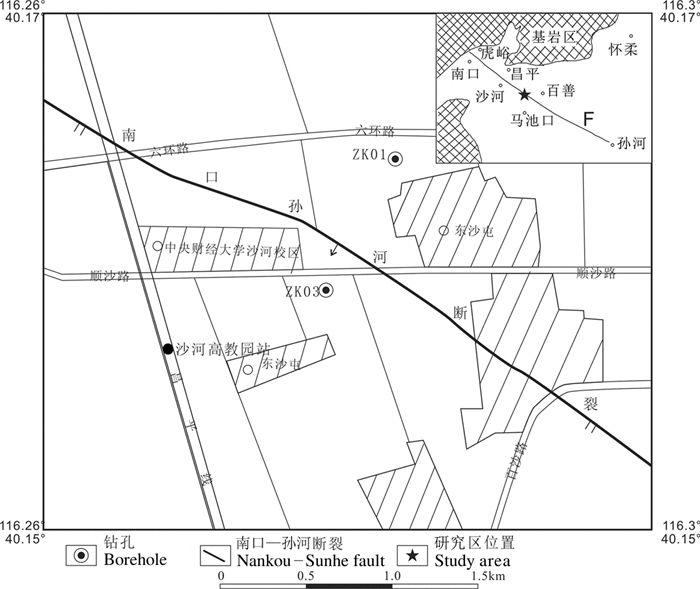
 下载:
下载:
